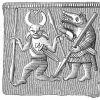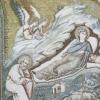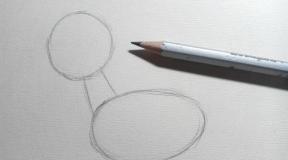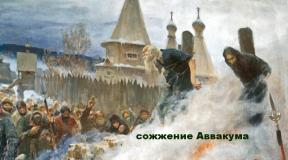Xerox country of origin. A Brief History of Xerox. The current stage of development
In 1906, the Haloid Compani company was founded in Rochester (USA), which was engaged in the production of photographic paper. A few decades later (in 1947), the management of the company acquired a patent for a copier previously developed by Chester Carlson. Still later, in 1958, the company was renamed Haloid Xerox, and in the year 1961 - Xerox Corporation. These are just a few moments from the history of today's most famous manufacturer of copiers and peripherals. In reality, there was a stunning take-off, then a near collapse, and finally a rebirth. All of this applies to Xerox.
Chester Carlson - inventor of the copier
In the 1930s, not all Americans had jobs that were well paid. As for the inventor of the first copying machine, Chester Carlson, he did have to start making money from the age of twelve, combining work and studies at college, and then at the California Polytechnic Institute. Chester graduated from educational institution with a bachelor's degree in physics.
After working as a janitor, janitor, printer assistant, Carlson sent out several dozen resumes. One of them was answered by the patent department of “P.R.Malloria and Co.”, hiring a young guy to work. The task was to photocopy and distribute copies of the drawings. The customers were various firms.
Methods of copying at that time were “grandfather's”: labor losses were enormous, there was a lot of marriage. It was for this reason that Chester came up with the idea of some method to mechanize his labor. Thus, the closet of his small apartment became a laboratory for conducting experiments and moving towards the goal. After 3 years of intensive work, Carlson and his partner received the first copy created using the electrostatic method. Having received a patent, the inventor began to offer the product of his labor to various firms.
Xerox: from first profit to millions of dollars
Demonstration of the first copying machine was often unsuccessful: the paper was damaged, copies were blurry. This forced Carlson to look for creditors, without whom further development was impossible. 3000 thousand dollars were allocated by the management of Bettel Memorial, under whose tutelage the inventor worked further. Haloid was the partner of Bettel Memorial. Later, a joint venture was formed - "Rank-Xerox".
After the formation of the new company, the main task of the inventor and the team was to improve the apparatus of the 914, which had several disadvantages. At first, it even went on sale with a fire extinguisher. The reason for this was the frequent fires of the paper. Over time, the model was nevertheless made more perfect, and thanks to a television commercial, it gained popularity. Since that time, these devices began to go not only on sale, but were also rented out.

In 1966, the company was already selling an improved model 813. It was 6 times smaller than the 914th. Later, the 2400 model appeared. The sales volume grew over the years, and it looked like this:
- In 1959, the volume was $ 32 million;
- In 1961 - 61 million;
- In 1962 - 104;
- In 1968 - 1125.
Decline in production and loss of sales market, return of leading positions
Virtually all of Xerox's success was due to the lack of competition at the time. After Kodak and IBM began to gain ground, Xerox fell on hard times.
Almost the collapse of the company forced the management to look for a variety of ways to solve the accumulated problems. One of these was an appeal to the consulting firm Nedler, who identified the main problems and drew up a further action plan. The main points were:
- Clear and clear formulation of tasks;
- Organization of innovations;
- Transfer of production to new rails.
The implementation of new ideas was impossible without new knowledge. To acquire them, Xerox management asked Phil Crosby to deliver a series of lectures on quality issues for senior management. The question arose about the complete retraining of personnel. With the aim of solving it, a training complex was built in Leesburg.
By the end of 1988, 100,000 Xerox employees had undergone retraining, which yielded excellent results: product quality improved significantly and profits began to rise. In the same year, the French, English and Dutch subsidiaries received a number of awards for their high quality products.
The year 1989 is one of the most successful in the history of the company: Xerox receives the Baldridge prize, which greatly strengthens its position in the copier and peripheral market.
In contact with
classmates
Xerox Corporation was founded in Rochester (New York, USA) in 1906. The founders named the company The Haloid Company. Then they did not even suspect what role their "brainchild" would play in the development of printing and copying technologies, and what a stellar future was in store for it.
During the first decades since its founding, the unremarkable company The Haloid Company produced photographic paper. The turning point in the development of the company was 1947, when the inventor Chester Carlson approached its management with a proposal to buy out the rights to the electrographic apparatus he had invented.

Electrographic inventor Chester Carlson at work
Having bought the rights and patents for electrography from Chester Carlson, The Haloid Company received its lucky ticket from life.
In 1947-1948. The Haloid Company, with the consent of Chester Carlson, renamed electrography to xerography, and electrograph, respectively, to Xerox. The word "xeros" was taken as a basis, which in translation from Greek means "dry" and "grapho" - writing, writing.
Commercially successful products
The first photocopier was developed by the Xerox Corporation (then The Haloid Company) in 1949. It was named "Model A".
The world's first photocopier Model A
In 1959, a fully automated office copier rolled off the assembly line of the company, using plain paper for printing. The device was a huge commercial success: in 1961 alone, the profit from its sale amounted to $ 60 million, and in 1965 - $ 500 million. In 1964, Xerox developed the Long Distance Xerography LDX fax machine, and in 1977 introduced the first Xerox 9000 Dover industrial laser printer at 120 pages per minute. At the same time, the Xerox DocuTech 135 digital printing machine with an industrial laser printing module was created. In 2000, a new generation of digital printing devices was launched - Xerox DocuColor 2000. 2002 for Xerox was marked by the release of the iGen3 digital printing machine, which won numerous exhibitions and competitions. In 2004, the Phaser 8400, the first industrial color printer, launched at a cost of approximately US $ 1,000 at a print speed of 24 pages per minute.
Renaming
Throughout its history, Xerox Corporation has changed its name three times. In 1906, the founders named it The Haloid Company. In 1958, inspired by the commercial success of xerography, The Haloid Company changed its name to Haloid Xerox Inc, and in 1961 to Xerox Corporation. The last name of the corporation remains to this day, it emphasizes the company's involvement in the emergence and development of xerography.
Logos and rebranding
During the existence of Xerox Corporation, its logo has changed 12 times.
 |
 |
||
| 1906 g. | 1938 g. | 1948 g. | 1949 g. |
 |
 |
 |
 |
| 1958 g. | 1961 g. | 1968 year | 1994 year |
 |
 |
|
|
| 1994 year | 2004 r. | 2008 r. | |
History of the development of the Xerox logo
Perhaps the most ambitious rebranding in the history of Xerox Corporation was carried out in 2008. Then a spherical symbol was introduced into the corporation's logo, on the surface of which two lines intersect, forming the letter "X". The logo symbolizes the relationship of the corporation with its customers and partners around the world.
Mergers and acquisitions
The Xerox Corporation marches triumphantly around the world acquiring assets of smaller companies. Table 1 provides information on companies whose assets were acquired in part or in whole by Xerox Corporation in 2006-2012.
Information about companies whose assets were partially or completely
acquired by Xerox Corporation in 2006-2012
| Years | Companies |
|---|---|
| 2006 year | Amici, LLC; XMPie |
| 2007 year | Advectis, Inc; Blackstone Valley Office Systems; Global Imaging Systems, Inc .; Image Quest, Inc; Inland Business Machines; Marbaugh Reprographics Supply Co |
| 2008 r. | Better Quality Business Systems; Precision Copier Service, Ind. DBA Sierra Office Solutions; Saxon Business Systems; Veenman B.V. |
| 2009 r. | ComDoc, Inc |
| 2010 r. | ACS (Affiliated Computer Services); ExcellerateHRO; Georgia Duplicating Products; Irich Business Systems; Spur Information Solutions; TMS Health |
| 2011 r. | Bennett's Business Systems; Concept Group; Education Sales and Marketing; GredenceHealth, Inc; Innova Consulting; MBM; Midwest Business Solutions; Miller Technology Solutions; Newfield IT; Premier Office Equipment; The Breakaway Group; Unamic / HCN; United Business Solutions; WaterWare Internet Services; Xerographic Solutions; XL World |
| 2012 r. | LaserNetworks; Lateral Data; Martin Whalen Office Solutions; RK Dixon; WDS |
Mergers and acquisitions are a great way to expand your influence into new markets. And Xerox is actively using this marketing tool, strengthening its position in the market.
Products
Over the years of its existence and development, Xerox Corporation has developed more than 20 series of printing devices: Color Presses, ColorQube, CopyCentre, DocuColor, Document Center, DocuPrint, DocuTech, FaxCentre, Nuvera, Phaser, Vivace, Wide Format, WorkCentre, WorkCentre Pro, and XDL ...

Another technology that deserves attention is HiQLed technology, which is a vastly improved standard LED technology. In printers with HiQLed technology, a new ASIC chip controls light output by continuously scanning and storing data in the printer's memory. A sensor on a line of LEDs transmits data about the light intensity on each diode to the HIQ chip. The light intensity is then digitally corrected across the entire LED array, 100% compensating for any misalignments, shifts and skews in the image.

HiQLed technology in action
Another achievement of Xerox Corporation is reusable paper, each sheet of which can be reused up to 100 times without loss of quality. Information printed on such paper disappears after 24 hours, and the sheets become pristine again.
The current stage of development
Xerox is currently headquartered in Norwalk (USA).

Xerox Headquarters in Norwalk (USA)
The company employs 140 thousand people, which is comparable to a small town. Interestingly, most of Xerox's employees still live in Rochester, New York, where the company was founded in 1906.
 Xerox Corporation has offices in 160 countries around the world and their number is constantly growing. The number of registered patents has exceeded 10,700.
Xerox Corporation has offices in 160 countries around the world and their number is constantly growing. The number of registered patents has exceeded 10,700.
In 2011, Xerox Corporation had turnover of $ 22.6 billion and net income of $ 1.3 billion. In 2011, Xerox was ranked 449th in the Fortune Global 500, a ranking of the largest companies in the world, the only criterion for which is revenue.
In 2011, Xerox Corporation spent $ 721 million (3.2% of its revenue) on research and development.
The popularity of the Xerox brand all over the world is evidenced by the fact that almost everywhere, including in Russia, the word "copier" is associated with the Xerox corporation and means "copying" or "copy".
Representative office in Russia
Xerox Corporation entered the Russian market in 1974, at the same time a representative office of the company with headquarters in Moscow was opened in Russia.
 Regional offices of Xerox are located in eight cities of Russia: Moscow, St. Petersburg, Vladivostok, Yekaterinburg, Rostov-on-Don, Novosibirsk, Tyumen and Kazan. Each representative office offers a full range of goods and services produced, sold and provided by the corporation.
Regional offices of Xerox are located in eight cities of Russia: Moscow, St. Petersburg, Vladivostok, Yekaterinburg, Rostov-on-Don, Novosibirsk, Tyumen and Kazan. Each representative office offers a full range of goods and services produced, sold and provided by the corporation.
The Xerox Russia partner network for the promotion and maintenance of equipment numbers more than 5,000 sales partners, as well as more than 300 authorized service centers, which provide absolute service coverage in 83 regions of the Russian Federation.
Xerox Web Site
 In Russia, the Xerox Internet representative office was opened in 2009. The goal of the project is to tell about the corporation's activities in Russia, show consumers its products, reflect all the peculiarities of the corporation's development and provide customers from any corner of the country with up-to-date information about Xerox products and services.
In Russia, the Xerox Internet representative office was opened in 2009. The goal of the project is to tell about the corporation's activities in Russia, show consumers its products, reflect all the peculiarities of the corporation's development and provide customers from any corner of the country with up-to-date information about Xerox products and services.
The Xerox website in Russia is organized at www.xerox.ru.
For English-speaking users, the Xerox Web site is available at www.xerox.com.
In contact with
On April 8, 1906, The Haloid Photographic Company was born - a manufacturer of photographic paper from Rochester (USA, New York), which became one of the largest IT corporations on the planet. After 109 years of activity, dozens of crises, more than 58,000 patents and several renames, Xerox Corporation is still ranked among the most successful companies in the world.
It was on the first Xerox Alto true personal computer, which never left the company's laboratories, that Steve Jobs first saw the graphical interface and the WYSIWYG (What You See is What You Get) principle, a computer mouse, raster graphics and work in a local network of several computers. Alto was the first to use the object-oriented programming language Smalltalk. Perhaps the entire computer and printing industries owe their emergence and development to the Xerox Corporation.
This is the story of one of the most innovative companies of the twentieth century, whose name has become a household name. But, as often happens, it all began with decades of failure.
Chester Carlson
In the 1930s, the Great Depression erupted around the world, resulting in hundreds of thousands of layoffs, which also fell victim to Chester Carlson, a California physicist who received his bachelor's degree in physics in 1930. After leaving the walls of the institute, he began looking for his first job, but 82 companies turned him down because of their own huge problems - a crisis, after all.
The last hope was a research engineer job at Bell Telephone Laboratories, a subsidiary of Alcatel and AT&T in New York. Chester worked there for a year, and then got a job as an assistant patent attorney and took up copyright protection. Here he first encountered the problem of copying a huge number of documents. The technologies of that time were endlessly dull and required a lot of time and effort. Basically, the documents were duplicated by "carbon copy", since other methods were much more expensive.
This work prompted him to find a new, better way of copying. While still an engineer at Bell Labs, he began jotting down ideas for inventions in his notebook - a useful habit that may have determined his fate. His early experiments, taking place in his own kitchen, were based on notes in his notebook, of which there were more than 400 by that time. The experiments were not safe - explosions, smoke and stench were frequent in the house. In one experiment, Chester watched the reaction of crystalline sulfur and a plate of zinc heated over a kitchen stove flame, resulting in sulfur burning and an eerie stench throughout the building.
Realizing the importance of the patent, Carlson documented every step of his research and filed preliminary patent applications. In 1938, his wife insisted that the experiments should take place elsewhere, and the villainous physicist rented the second floor in his mother-in-law's house. Together with his assistant, the unemployed Austrian physicist Otto Kornei, Carlson continued his experiments.
Chester knew that big companies were also looking for new copying solutions, but they were moving in a different direction. The Haloid Company owned Photostat, an Eastman Kodak copier that specialized in copying drawings and photographs. In addition, all decisions of those years required special chemicals and paper.
Electrophotography and 9 years of wandering
On October 22, 1938, the first electrophotographic print was printed. Simplified principle of operation of the device: the drum is charged using a corotron; with the help of a lamp and a system of mirrors, exposure occurs, as a result of which the drum loses its dielectric properties where the light falls. Toner with oppositely charged ink passes in front of the drum unit, causing the ink to be attracted to the charged areas of the drum. A sheet of paper is rolled, the ink is fixed on it using heat treatment, the toner of the drum is cleaned.



For 6 years, Carlson tried to prove to businessmen that his invention is extremely necessary for the world, but in response he received only remarks about the imperfection of the product - huge dimensions, constantly getting dirty sheets and low speed of work. He was turned down by more than twenty organizations, including IBM and the US Navy, which needs a "dry" print, who did not see anything innovative in the technology.
In 1944, just as Carlson was about to abandon his idea, a young engineer from the Battelle Memorial Institute, Russell Dayton, was called in by an expert to appeal another case. He impressed Chester as an "innovative" man. Although Russell had never helped inventors before, he really liked the idea of electrophotography.
They went to Columbus, where they showed the invention to the engineers and scientists of the institute. Carlson said:
Perhaps it looks like a raw product. But you saw for the first time a reproduction of something obtained without a single chemical reaction and using a dry method.
Bastelle took up the idea of the physicist, although the work seemed strange to them. It was not based on any scientific work, the principles were not formulated and generalized - they were just sketches, ideas and a series of phenomena, as a result of which a copy appeared. However, only the result mattered. And the fact that Carlson did everything without special devices and outside the "favorable scientific atmosphere" aroused respect, because many scientists were also engaged in research in this direction.

In the fall of 1945, Battelle agreed to act as Carlson's guarantor for his patents, pay for further research, and develop the idea. Battelle tried to get large print and photography companies like Eastman Kodak and Harris-Seybold to license the idea, but to no avail.
The Haloid Photographic Company
On April 18, 1906, the first factory of the new company engaged in the production and sale of photographic paper began operating in Rochester. Entrepreneur M.H. Kuch took an interest in the growing niche of photographic technology, as it was between 1902 and 1907 that the field of color photography developed rapidly. The next 32 years (!) The company grew moderately along with its market, only expanding its products with photographic equipment and accessories.
In the fifties, Haloid began to look for ways to develop, as the neighboring company Eastman Kodak completely overshadowed them, which presented big problems for the business. John Dessauer, head of research, read about Carlson's invention in the newspaper and saw a new niche in which they could outstrip Kodak.

In 1946, Bastelle and The Haloid Phorographic Company struck a deal granting Haliod's rights to use electrophotography. The institute continued to develop technology - reducing the size and inaccuracies of printing, and the company began to produce a commercial product.
In 1948, Haloid CEO Joseph Wilson convinced the US Army Signal Corps - the state corporation that provides absolutely everything to the US Army - to start funding the production and research of dry printing technology. The state feared a nuclear war, because of which all modern photographic, X-ray and copying devices could be disabled. The radiation greatly affected both the film and the chemical reactions with the old copying methods. As a result, half of Haloid's revenue this decade came from government contracts.
At the same time, a professor-philologist from Bastelle notes that the term "electrophotography" is dissonant and suggests "xerography" (zirography, from the Greek ξηρός "dry" and γράφω "I write"). Carlson is not very happy with the idea, but Haloid is approved, accepted, and begins to promote the term.
After ten years of operation, Bastelle is slowing down the technology and renegotiating the contract, giving up almost all rights to use Haloid. Carlson and his family move to Rochester, becoming a consultant for the company.
Xerox. Start
 Development of the first commercial product continues and testing of the first fully automatic photocopier of acceptable dimensions begins. In the course of five years of development, it was possible to reduce the size of prototypes by more than half and significantly increase the speed qualities of the models. So, in 1949, the Xerox Model A was born.
Development of the first commercial product continues and testing of the first fully automatic photocopier of acceptable dimensions begins. In the course of five years of development, it was possible to reduce the size of prototypes by more than half and significantly increase the speed qualities of the models. So, in 1949, the Xerox Model A was born.
It was a very compact copier with a very difficult process to use. It took 39 steps to get the seal, mostly by hand. Model A is not a very successful product, but it showed the industry's willingness to produce the right type of paper at the right scale.
In 1958, the board of directors agreed to CEO Wilson's old idea to rename the company. From now on, the company was called Haloid Xerox, which declared its priorities.
Xerox 914
The most important product of the company in its entire history. The large size relative to the Model A was offset by the merits of a fully automated copying process and lucrative distribution schemes - the car could be rented for $ 25 a month. Together with the purchase of paper, it came out less than $ 50 per month, which was a great solution for any business.

Interestingly, on the first demonstration of the product, one of the two copiers caught fire, completely burnt out, while the other did a great job. But even such an idea did not affect the sales of the device. After the release of Xerox 914, the company's profits doubled. This prompted another name change, now to Xerox Corporation.
Fortune magazine called this 36kg machine "possibly the most profitable product ever made in the United States." You know the rest - by 1968 the company's sales exceeded $ 1 billion.
Jack Trout, marketer
For Chester Carlson, the Xerox 914 was the "crown jewel" of his creation — exactly the kind of device he had always dreamed of creating. After the release of this model, Carlson's involvement in the life of the company became less and less and he took up charity work. 
Xerox began working on laser printers in 1969. Success in this direction was achieved in 1978 by an employee of the company Gary Starkweather, who was able to add a laser beam to the operating technology of existing Xerox copiers, thus creating the first laser printer. The full duplex Xerox 9700 could print 120 pages per minute (by the way, it is still the fastest laser printer in the world). But the high price of 350,000 dollars and the sheer size put an end to successful sales.
Xerox PARC and Apple
The 70s almost became the last in the history of the company. In 1970, a new direction for the company's development was chosen, announced at a meeting of shareholders:
“Xerox and IBM are two large companies that focus exclusively on information technology. In the hands of IBM are the means of data processing, in our hands - the technology of their transfer to paper. But the boundaries between them are blurring: it becomes more and more difficult to distinguish one from the other. Already in the 1970s, we should be able to tell any large client: “We can meet any of your information needs. Including in data processing ”.
Peter McCollough - CEO of Xerox Corporation in 1970
The company decided to pursue other industries - information technology and innovation. This is how Xerox PARC - Palo Alto Research Center was founded. One of the most important IT organizations in history. The company started a big battle on the IBM field, not knowing that they would be defeated on their own.
By underestimating Japanese manufacturers, Xerox lost 86% of the US copier market after being a monopoly a few years ago. Canon's cheaper and simpler technology targeted small businesses and home systems than it was able to conquer nearly the entire market in less than a decade.
However, the course was chosen, and in 1973, the Xerox Alto, the computer that played the most important role in the history of personal computers, was assembled at PARC Laboratories. This role was to catch the eye of Steve Jobs.

It happened in spite of everything. Jeff Raskin, a computer interface specialist, was convinced that the Xerox Alto graphical interface was the future of computers.
Ruskin urged Jobs and his Apple colleagues to travel to Xerox PARC to see the Alto. But it wasn't that easy. Jobs thought Ruskin was a nerdy theoretician, called him a "fucking dumbass." Ruskin had to win over to his side his student Bill Atkinson, who, according to Jobs' classification, fell into the category of "geniuses"; this was the only way to get Steve interested in Xerox PARC projects.
Walter Isaacson, Steve Jobs: A Biography
24-year-old Steve Jobs, when he first saw the innovation of Xerox, as he himself says, "was blind." Nevertheless, realizing the potential of the inventions, Apple bought out the rights to use everything it saw in the PARC laboratories, in return giving Xerox the opportunity to buy back part of Apple's shares before its IPO. In this case, if Xerox's internal inventions are successful, they will be able to capitalize on it. And so it happened, the shares bought for $ 1,000,000, by the time the company went public, were already worth $ 17,600,000. Apple's meetings with Xerox PARC have an entire chapter in Jobs' biography.
Jobs himself said that Xerox could become market monopolists, as they owned the most advanced solutions, both software and hardware. But because the engineers had no idea about the final product, the company lost that opportunity forever.
Once they got what they wanted, the Apple team set about refining the prototypes. A three-button mouse and software were considered inconvenient for it, and Jobs demanded to completely change it - control had to be based on one button, the cursor had to move more smoothly, for which it was necessary to use the "wheel". As it often happened, the manager of the development department was fired and replaced for remarking that this was impossible. The people involved in the display said the same - it was required to make it white and the font black, which was important for the implementation of the principle of "WYSIWYG" - you get what you see. However, the task was completed.
The graphical part has also been greatly changed. The requirements were maximum smoothness and the ability to work with several programs at once - the concept of "windows", called "areas" in the company. Displaying a bitmap image on the screen itself was a very resource-intensive task - all computers then had luminescent dark green lines on the screen. I pressed the button - the symbol appeared. In a monitor with pixels, every pixel must be processed by the system. Therefore, the Apple engineers faced very difficult tasks.
Three years later, the Xerox management realized that something needed to be done in this direction, and the development continued. Apple tensed. In 1981, the Xerox 8010, known as the Star, went on sale. It was designed for the corporate segment - the cost of the computer itself was $ 16,000, and the workstation with all the additional equipment added to the price tag another $ 75,000.
Jobs believed that Xerox had a chance, but they ruined it, making it clear that they were not dangerous.
IBM and informatization
Following the path of enslaving the information sphere, the company tried to create information networks. First, within the room - several machines, which are one workstation, later within the office, for the local network and servers. The last stage was to be a huge telecommunications system in America, and later around the world, connecting hundreds of offices of different corporations.
The Xerox Telecommunications Network was to be based on Western Union, which was immediately acquired. After three years of development, the idea was recognized as a mistake, and everything purchased was sold at huge losses. Perhaps this was another mistake of Xerox, because such a network, over 10 years of development, could transform into something similar to the modern Internet.
It is noteworthy that the company tried not so much to engage in new directions as to stop being associated only with printers and office supplies. This is what the renowned marketer Jack Trout thinks in his book Big Brands, Big Problems. He is very skeptical about the company's activities after the 1970s, believing that every time Xerox did exactly what it shouldn't do at the moment. This concerned both the huge resources of the company invested in promoting the idea of “Xerox is more than a print” and the principles of economic policy. Trout believes that if the company were to remain the leader in their field, they would become IBM from the world of printing.
We do not know how much the development of computers would have slowed if in the 1970s IBM had not had so many competitors, primarily Apple. However, we can definitely say that it was Xerox who played a key role in this.
End of the twentieth century, our days
Since the release of Memorywriter, an electronic typewriter, the company has made several more attempts to redefine itself. The purchases of insurance companies, the provision of analytical services, the organization of charity funds - nothing has influenced public opinion.
The company remained Xerox (Zirox). The very company that makes printers and office equipment. However, this does not prevent it from remaining a successful corporation today with an incredible past. And who knows, maybe Xerox's biggest discoveries are in the future.
Slogan: Technology. Document Management. Consulting Services.
To paraphrase the classic of communist poetry, we can say "We say copying documents - we mean Xerox"... Indeed, after all, almost everywhere, including on the territory of the entire former USSR (where this brand came already back in 1968), the word "Xerox" means copy or copy.
It all began in 1906, when a company was formed in Rochester, New York. The haloid company, engaged in the production and sale of photographic paper. For quite a long time, the development of the company proceeded at a moderate pace.
The year 1938 was marked by the discovery made by Chester Carlson, a lawyer by profession, an inventor by hobby. In his makeshift laboratory, he creates the world's first "electrophotographic" print, when an image is transferred to paper using a photosensitive semiconductor and dye powder. Being well versed in copyright issues, Carlson immediately patented his invention - patent number 2,297,691, dated 1942. However, it took almost ten years before the invention attracted the interest of manufacturers.
In 1947 The haloid company buys out all rights to his electrophotography from Carlson. And the next year, the term was changed to a more euphonious "Xerography"(from Greek words, "Xeros" – "dry" and "Grapho" – "write"). At the same time, the trade mark was born. Xerox... In 1949, the first photocopier with the unpretentious name Model A appeared on the market.
The success of these products on the market led to the fact that on April 16, 1958, the company changed its name to Haloid Xerox Inc... This is done in order to emphasize that the main activity of the company will henceforth be xerography.
 |
In 1959, the Xerox 914 was introduced. It was the first fully automatic office copier to use plain paper. The device was a huge commercial success, with the company changing its name to Xerox Corporation.
1970 leadership Xerox decides that after taking over the “paper” realm of the office, it's time to take on the realm of data processing by challenging IBM... Research center established Xerox Computer Services located in Palo Alto, California. For this, the company was bought Scientific Data Systems, engaged in a computer.
Companies Xerox belongs to many outstanding inventions. However, she was unable to take full advantage of them. Consumers perceived the company solely as the creator of copying systems. Much More Trust in a Computing System Manufacturer IBM... One of the most striking achievements Scientific Data Systems is a computer mouse and graphical interface implemented on the Xerox ALTO computer in 1974. However, neither one nor the other interested the company's management, which simply did not see any prospects in them. But they were interested in Steve Jobs, who had been "on a friendly visit" to the laboratory. He immediately realized that before him was an ingenious invention. As a result, the company Apple Computers became the first to equip its computers with a graphical interface and mice. Understand the full depth of loss Xerox managed too late. It was later "avenged" by Bill Gates, who "borrowed" a graphical interface from Jobs' company.
 |
Xerox's achievements have played a huge role in the development of laser printers and computer networks. As a result, she managed to squeeze IBM in the output of information on paper, but not in the processing of data.
But the main headache Xerox brought at all to IBM, and Japanese manufacturers. When did it start to supply its products to the US market? Canon, no one took her seriously. After all, it was simple and cheap, designed for small business, or even home use. But time has shown the correctness of the Japanese approach, and Xerox lost the title of absolute leader in copying documents.
The company decided to emphasize its belonging to the world of documents in 1994, presenting the world with a new logo - "The Document Company - Xerox"... However, in 2004 it was simplified. And four years later they presented "Red ball", which other users jokingly dubbed "Kyrgyz flag".
Today Xerox remains one of the largest manufacturers of equipment for offices of various levels. In addition to copiers, printers, faxes and much more are produced. The company is also engaged in stationery. Xerox owns thousands of patents on a wide variety of topics. Its revenues are in the tens of billions of US dollars.
Over the years of its existence Xerox has absorbed more than one company associated with the development of software or the creation of computer systems. The largest joint venture is Fuji Xerox, founded in 1962, working with technology Xerox and accessories for her in the Asia and Pacific region. On the territory of India there are Xerox India(previously Modi Xerox). There is also Rank Xerox- joint venture with Rank Organization from the UK, engaged in the production and sale of Xerox equipment in Europe and Africa.
Vladimir Fridkin
Doctor of Physics and Mathematics, Professor Vladimir Mikhailovich Fridkin is known to the readers of Science and Life as a writer, author of fascinating stories, including about Alexander Pushkin and his time. (By the way, the Fizmatgiz publishing house is going to publish his new book "Invented stories about love." He said that he did not want to write popularly about physics. However, this time he gave up his principle. And the reason was the following event. In May this year, the International Committee for Imaging Science awarded V. Fridkin the Berg Prize for "outstanding contribution to the development of unusual (non-silver) photographic processes and international cooperation in this field." Xerography is a photographic process based on purely physical phenomena. In 1953, V. M. Fridkin, who had just graduated from Moscow University, created the first xerox machine, and subsequently developed the theory of xerography. Now a copier is installed in every institution, and fax communication and dozens of other technologies are impossible without xerography. And fifty years ago it was a miracle. And this miracle was born in Russia. On the occasion of the anniversary, our highly respected author agreed to write the first popular science article.
Science and Life // Illustrations
Discoverer of Xerography Chester Carlson (1906-1968). Photo with a dedication to V.M.Fridkin (1965).
Bulgarian academician Georgy Nadzhakov (1896-1981), who discovered photoelectrets.
The International Committee for Photographic Science awarded V. Fridkin (in May 2002) the Berg Prize. It is awarded every four years for outstanding contributions to this field.
The first electrophotograph obtained by V.M. Fridkin in the fall of 1953 (photo from the original).
This is how EFM-1, the first copier, looked like. 1953 year.
The main stages of electrophotography on a photo electret: 1 - polarization under illumination (through the negative); 2 - grounding of electrodes; 3 - manifestation; 4 - transfer of the developed image from the surface of the photoelectret onto the paper; 5 - fixation; 6 - surface cleaning
Academician Alexei Vasilievich Shubnikov (1887-1970) - famous Russian crystallographer, founder of the Institute of Crystallography of the Russian Academy of Sciences, teacher and mentor of V.M. Fridkin.
Chester Carlson and V.M. Fridkin (right) at the Institute of Crystallography of the Russian Academy of Sciences (1965) (one of the first electrophotographs taken from nature).
In the laboratory of NIIPoligrafmash. From right to left: I. S. Zheludev, Georgy Nadzhakov, H. Bilyaletdinov, T. Gerasimova, V. M. Fridkin, A. A. Delova, Nikifor Kashukeev (employee of Nadzhakova) (1956
Colloquium on Electrophotography in Munich (1981). Left - V.M. Fridkin - the creator of the first photoelectric copier. Right - Professor H. Kalman, thanks to whose work xerography on photoelectrets has found application in space.
In the photo from left to right: Russian scientist A. Shlensky, professor Jacques Leviner - director of the institute, V. M. Fridkin.
In this post I want to tell you about the history of the creation of the first photocopier. Moreover, it was made in Moscow and I have a direct relationship to this story. Today xerography is the basis of duplicating technology. Without it, there would be no faxes or computer printers.
But you have to tell it in order. After all, xerography is a part of modern photography. It is also called non-silver or dry photography (from the Greek word "copier" - dry).
The date of birth of photography is considered to be 1837, when the Frenchman Joseph Nicephorus Niepce received the first images on a plate covered with a layer of light-sensitive asphalt varnish and exposed to light. The method is based on the fact that the illuminated and unlit areas of the film dissolve in different ways in lavender oil. A year later, Louis Jacques Daguerre obtained a photographic image on a film of silver iodide. In the film, under the action of light, a photochemical reaction took place and a latent image appeared, which was manifested by mercury vapor. Now these first daguerreotypes can be seen in Chalon, in the museum of photography, near Paris. (The photograph was born in the year of Pushkin's death. Therefore, we do not know his photographs. But the daguerreotypes of his children are known.)
Modern silver halide photography was created in the 70s of the 19th century, when silver bromide films sensitized with dye molecules began to be used as photographic material. Dye molecules absorb light in the visible spectral region, which increases the photosensitivity of photographic films by hundreds of times. This paved the way for the invention of cinema and the application of photography in astrophysics, nuclear physics, elementary particle physics - practically in all areas of science and technology. And not only in science and technology. Without photography, one cannot imagine either today's life or the modern history of human civilization.
Until the middle of the last century, photography as a science was part of photochemistry, since both the formation of a latent image and its manifestation were based on photochemical processes. Xerography is a new photographic process based on purely physical phenomena using the photoconductivity of semiconductors. And here it is necessary to tell about everything that led to the creation of the first photocopier.
The main events took place independently in 1938 on different sides of the Atlantic.
In a small room at the Astoria Hotel in New York (Long Island), Chester Carlson (1906-1968), a physicist who served in a patent office, did the following experiment: he friction electrified a plate of polycrystalline sulfur and illuminated it through a film carrying an image. Sulfur is a photoconductor nickname. Under illumination, current carriers, electrons, or holes appear in the photoconductor. They discharge the illuminated areas of the photoconductor, therefore, after light exposure, a latent image appears on the sulfur surface, formed by charged and discharged areas. If such a surface is sprayed with a charged powder carrying an opposite charge, the particles of the powder will develop an image. For the manifestation, Carlson used the triboelectric effect, which has long been known in physics. He mixed powders of red lead and sulfur (the particles of which, in contact with each other, are charged with opposite charges) and pollinated a plate of sulfur. Red lead particles have developed a latent image. The lines appeared on the surface of the plate: "Astoria", October 22, 1938. This date should be considered the birthday of xerography.
Of course, advanced technology is at the heart of modern xerography. The photoconductor is charged not by friction, but by a corona discharge. With its help, the developed image is transferred to paper and then fixed. As a photoconductor, a material that is more light-sensitive than sulfur is used, for example, an amorphous alloy of selenium with tellurium.
In the same 1938, a young physicist Georgy Nadzhakov worked in Paris on the Rue Vauquelin at the Institute of Mary and Pierre Curie (it was here that the Curies discovered the natural radioactivity of radium). In the laboratory headed by the famous French physicist Paul Langevin, G. Nadzhakov discovered the so-called photoelectrets. He found that when an external electric field of some photoconductors is illuminated, an internal electric polarization arises in them, which persists for a long time in the photoconductor. Outwardly, it resembled the magnetic polarization of ferromagnets. Therefore (by analogy with a magnet) Nadzhakov called a photoconductor with constant electric polarization an electret. The polarization of the photoelectret can be destroyed by re-illumination of the photoconductor in the absence of an external field.
The mechanism for the formation of a photoelectret is now well understood. It is associated with the localization of charge carriers (electrons and holes) in deep traps, which ensures the "long life" of the polarization. An interesting coincidence: Nadzhakov, like Carlson, used polycrystalline sulfur as a material for the photoelectret.
Fifteen years later, these two discoveries unexpectedly met and gave birth to the first photocopier. And here it is already necessary to talk about yourself.
I graduated from the Physics Department of Moscow State University in December 1952, when the "doctors' case" was raging in the country. He graduated with honors, while still a student, having published two scientific articles. They didn’t take me to work, and my mother, a hematologist, was kicked out of the hospital. There was nothing to live on. The father, who died in the war, was a printer. His friends gave me a job at NIIPoligrafmash: a small institute at the factory, huddled in tumbledown houses behind the Textile Institute. There, several designers were sitting at the drawing boards, drawing details of printing machines. Physics, as they say, did not smell. The director, a friend of my father, took me into an empty room, where there was a table and two chairs, and said: "Take yourself something. Perhaps it will soon feel better." No one knew yet that they would feel better in two years, after the 20th Party Congress.
I wasted no time. I went to Leninka, read physics journals, acquired some equipment. And then I stumbled upon Nadzhakov's articles and Carlson's patent in the literature. I got the idea to implement a new photographic process (I called it electrophotography), in which the photoelectret served as a photosensitive layer, and the development was carried out using the triboelectric effect (as in Carlson's). The new photographic process was also conceived as a method for creating optical memory, since, unlike Carlson's process, the photoelectret not only formed, but also memorized the image. The latent image could be stored for quite a long time, and it could be developed long after the exposure.
The layout was done quickly. Following Nadzhakov's example, I used polycrystalline sulfur and then other photoconductors such as zinc and cadmium sulfide. Development was carried out with asphalt powder. In the photo, the reader can see the very first image taken in the fall of 1953 (the original was a slide). Soon, the plant made an apparatus, which was named EFM-1 (electrophotographic duplicating machine). The number "1" apparently meant that others would follow the first model. This "historical" apparatus is shown in a drawing borrowed from my book, published many years later. Its operation is clear from the diagram shown in the figure.
"All of Moscow" came running to look at the electrophotograph. She has been shown in films and on television. The minister arrived, and a meeting was held at the institute. We discussed what to do next, how to implement it. In Vilnius, under the leadership of a talented engineer and inventor Ivan Iosifovich Zhilevich, a scientific center was organized and named "Institute of Electrography" (before that, II Zhilevich's group in Vilnius was considered a branch of our laboratory). In Chisinau, they found a plant that was instructed to produce EFM (in 1954 the word "copier" had not yet come into use, and the copier itself appeared on the western market only at the end of the 50s).
Many years later I learned that in the USA, in the company "Haloid" (later renamed "Xerox"), at the same time the first models began to appear. But, as I said, their work was based on a different principle.
The director of my institute was bathed in the rays of glory: "You see," he said, "I predicted you ..."
In 1955, Academician Alexei Vasilievich Shubnikov, director of the Institute of Crystallography (where I work to this day), invited me to graduate school. He was interested in the topic of electrets. Under the direct supervision of Professor I. S. Zheludev, I wrote my thesis "Photoelectrets and Electrophotographic Process". Not only the time has changed, but also the place of work: an academic institute, a rich laboratory and library, conditions for creative work. Once Aleksey Vasilyevich invited me to talk about my work at a seminar with PL Kapitsa - in the "kapishnik", and Pyotr Leonidovich spoke very warmly about the work, predicting a great future for it.
Now, while working at the Academy of Sciences, I was also connected with the outside world. It turned out that Georgy Nadzhakov, the discoverer of electrets, became vice-president of the Bulgarian Academy of Sciences, and we established close cooperation. In June 1965, Chester Carlson visited our laboratory at the Institute of Crystallography. The founder of Xerography became interested in my articles. We were photographed together with an electric camera on an electret. In the late 1950s, Columbia University professor Hartmut Kalman and his co-workers repeated my experiments on electrophotography using photoelectrets and found an interesting application for it in space communications. He spoke about this at a colloquium in Munich, where we met in 1981. For these works, the American Photographic Society awarded me the Kozar Medal, and the German and Japanese ones elected me an honorary member. I also visited the Institute of Mary and Pierre Curie in Paris, where Nadzhakov once discovered a photoelectret.
All these years, I did not break off ties with NIIPoligrafmash and moved my device to a new place of work, although in the early 60s I took up a different topic, and the EFM was pushed into the far corner of the room. At that time, photocopiers were a rarity in our country. They were bought for currency and were only available in important institutions. They stood in specially guarded rooms, where high-ranking officials took copies of documents against receipt. In our institute, each employee could make a copy of the required article or document. But this did not last long.
As you know, in the 60s the struggle against "samizdat" began. The manuscripts of A.I. Solzhenitsyn and other forbidden authors were reproduced at night on typewriters on thin tissue paper. And here the copier is unattended! They came to me from the directorate and announced that the car should be dismantled and destroyed. It took me a long time to explain that my experimental setup was the first copier in the world to work on a new principle. Everything turned out to be useless. I did not go to Alexei Vasilievich. The copier was taken apart and thrown into a landfill. But one detail has survived. The photoelectret plate had a mirror surface, and our women adapted it as a mirror in the toilet. Soap and toilet paper were never there, but a mirror appeared. So the fate of the world's first photocopier ended ingloriously.
The reader will ask, what about the plant in Chisinau, the Institute of Electrography in Vilnius? Where are they, Soviet copiers? Why did we buy and buy with currency? If only copiers ... Our Russian science in many areas has stood and is at the head of world progress. But to this day we do not sell high-tech products and feed on the oil "pipe". Why? Let the reader answer this question.
V. M. Fridkin. The Phisics of the Electrophotographic Process. Focal Press, London, 1973.





















